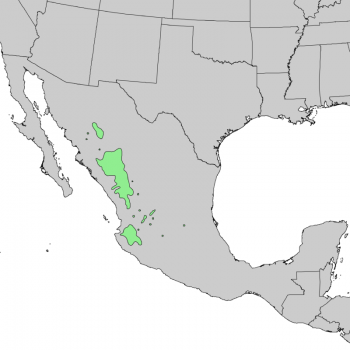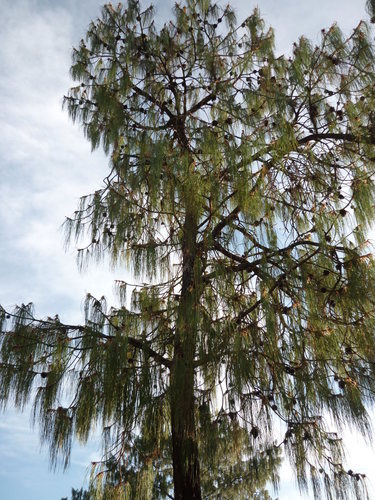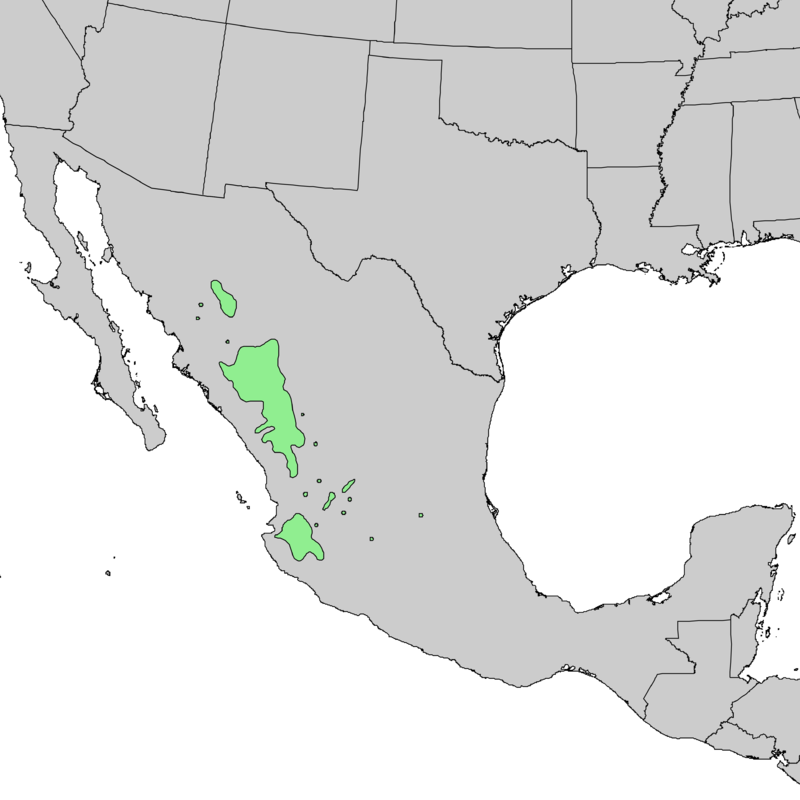subgenus Pinus, section Trifoliae (Duhamel), subsection Australes (Loudon).
Pinus lumholtzii, first described in 1894 by B.L. Robinson and M.L. Fernald in records of new plants collected by C.V. Hartman and C.E. Lloyd upon an archeological expedition to northwestern Mexico under the direction of Dr. Carl Lumholtz, published in Proceedings of the American. Academy of Arts, vol. 30. It is commonly known as Lumholtz's weeping pine; as well as Pino triste (literally, "sad pine") in the Spanish language; and sa wá in the local indigenous Rarámuri language. The species name honors Carl Lumholtz (1851 - 1922), who led the scientific expedition on which the type was discovered.
According to Chris Earle on conifers.org, "this is one of those species that elicits the first impression, "what is THAT?" The long needles, hanging absolutely lax and pendulous from the branchlets, readily distinguish it from any other pine. It also has one of the smallest cones found on Mexican pines."
Ethnobotany. According to the Sierra Madre Alliance, indigenous people use the trunk and branches to make tools. Although some populations have been over-exploited for timber production, it is generally not an economically significant species.
Description. Lumholtz's pine is an evergreen coniferous species of tree that grows to mature heights of 65 feet (20 m) with a usually round, straight, erect trunk, 20 to 28 inches (50 - 70 cm) in diameter, measured at breast height; and a broad, rounded, open crown.
- Bark is scaly and flaking, colored red-brown on young trees, later becoming thick, scaly, rough, divided into irregular elongated plates divided by deep, broad longitudinal fissures, eventually aging gray-brown to gray.
- Branches are long, spreading, and ascendent. Higher-order branches are flexible and drooping.
- Shoots are ridged between decurrent pulvini, glaucous at first, later red-brown, finally turning grey.
- Fascicle sheaths measure 1 to 1.4 inches (25 - 35 mm) long at first, soon coming apart to form a tuft of curling scales at the base of the fascicle, which is later deciduous.
- Leaves (needles) are borne in fascicles of 3 (rarely 2 or 4), extremely pendulous, persisting two years on the tree, lax but not thin, measuring 8 to 12 inches (20 - 30 cm) long by 0.048 to 0.06 inch (1.2 - 1.5 mm) thick. Individual needles are light green in color with serrulate margins and acute tips. Conspicuous bands of stomata appear on all leaf faces.
- Pollen cones appear sparsely clustered near the proximal end of new shoots. Each is cylindrical in shape, 0.4 to 1.2 inches (20 - 30 mm) long by 0.2 inch (5 mm) wide at maturity, colored pinkish turning yellow at maturity.
- Seed cones are borne subterminal or lateral, developing solitary (or occasionally in whorls of 2, rarely 3) on 0.4 to 0.6 inch (10 - 15 mm) long curved peduncles that fall with the soon-deciduous cones. Young cones are broadly ovoid to subglobose with curved spines, maturing in 2 seasons after pollination. Mature cones are ovoid; when open, measuring 1.4 to 2.2 inches (3.5 - 5.5 cm) long by 1.2 to 1.8 inches (3 - 4.5 cm) wide.
- Seed scales are thick and woody, number 70 to 90 per cone, spreading wide at maturity. Adaxial surfaces are dark brown with light brown marks of seed wings. Apophyses are slightly raised, distally thickened, obscurely transversely keeled, rhombic to pentagonal in outline, and ochre to red-brown in color. Umbos are oriented dorsally, flat or slightly raised, up to 0.2 inch (5 mm) wide, with a minute, soon-deciduous prickle.
- Seeds are obovoid shaped, slightly flattened, measuring 0.12 to 0.15 inch (3 - 5 mm) long, colored dark brown. Seed wings are articulate, measuring 0.4 to 0.56 inch (10 - 14 mm) long by 0.16 to 0.24 inch (4- 6 mm) wide, colored light yellow- or gray-brown.
Distribution. This species is native to Mexico - Aguascalientes, Chihuahua, Durango, Guanajuato, Jalisco, Nayarit, Sinaloa, Sonora, Zacatecas; throughout, in the Sierra Madre Occidental. It occurs at elevations of 5,600 to 8,500 feet (1,700 - 2,600 m) above sea level, which corresponds to the lower and middle slopes of the Sierra Madre. The climate is summer-wet with 20 to 25 inches (500 - 600 mm) of annual precipitation.
Hardy to USDA Zone 8 - cold hardiness limit between 10° and 20°F (-12.1° and -6.7°C).






